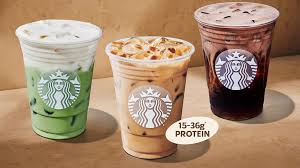Why everything has protein now
Aaron Stanway

US/ International News Editor
At the beginning of October Starbucks unveiled their protein packed drink menu, charging a premium to add protein to your coffee. This trend has been sweeping the food industry for years making everything into a high protein option. This begs the question, does everything need to be high protein?
Protein has always been essential to the human diet but recently, everything normal has gotten a protein version. We have protein pop tarts, protein sodas and even protein cold foam at Starbucks now. Every food option has a high protein version.
Protein marketing came on the rise mainly through bodybuilding in the 90’s. It took the form of protein shakes and powders, things meant to be supplements. Then in the 2000-2010 era it began to expand into every facet of the modern grocery store. This came on with the heathy living boom from that era as high protein snacks were marketed as being more healthy than regular alternatives.
However, as many things are, this came to become too good to be true. The trend first propped up by a healthy appearance quickly became a marketing gimmick that often used to mislead people into thinking what they are eating is healthier than it is.
To start, we have the insanity of protein packed foods that have no business being high protein. Things like protein cookies, and chips seem like good alternatives until you peek at the ingredients. These foods are often so highly processed and full of fake ingredients that it makes you wonder if the extra macros is worth it. Often they are filled with low quality protein and hydrogenated oils that are found in the regular products, hardly making the switch more health conscious.

In addition to that protein foods often face a dilemma of either tasting terrible or adding enough calories to make them practically the same as a regular snack. A great example of this is cookies. Many protein cookies will claim to have 12 grams of protein and be healthier than the regular while simultaneously having 300+ calories. These products can very often have more calories than the foods they are trying to replace. The alternative of course is to create something that is high protein and low calorie but tastes absolutely awful. It is a balance that is often impossible to strike especially without adding a ton of bioengineered food ingredients.
High Protein foods have become less of a more healthy option and more of a cheap marketing tactic used to take advantage of people who don’t know better. Protein packed options often are filled with ingredients that are hyper processed or are higher calorie than the original food. As long as the protein trend is still around, companies will be willing to charge a premium for an option. Starbucks is the most recent culprit creating a protein latte that costs up to 9$ for a Grande.
Contact Aaron.Stanway@Student.Shu.Edu
